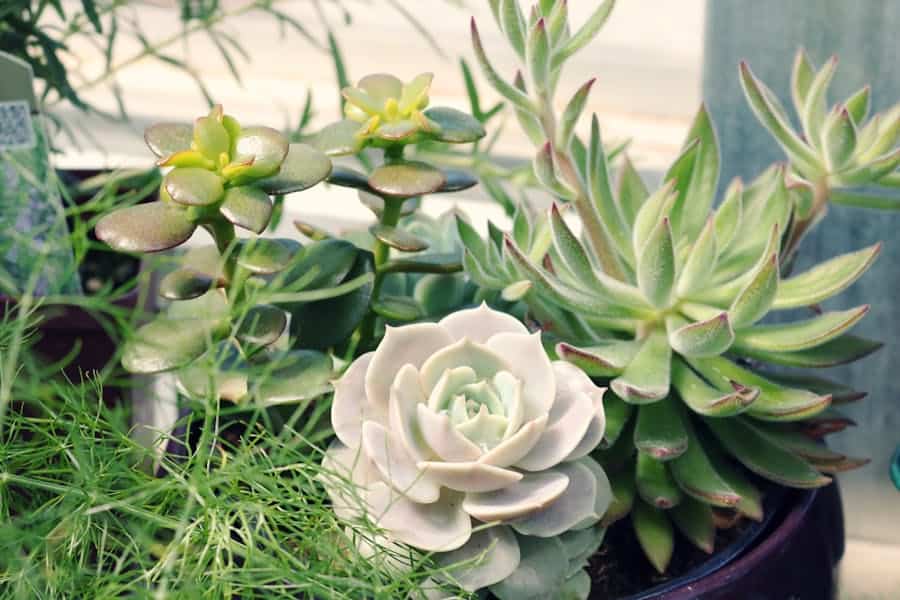With their diverse shapes and easy-care reputation, succulents have become a popular choice for novice and experienced gardeners. However, despite their hardy nature, there needs to be more clarity about their need for light, often leading to either overexposure or inadequate lighting. This article aims to demystify the light requirements of succulents, shedding light on how these resilient plants use light to thrive. Whether nurturing a windowsill collection or a backyard succulent oasis, understanding the nuances of light exposure is critical to keeping your succulents healthy and vibrant.
Do Succulents Need A Lot Of Light?
Succulents generally require much light to thrive, but not all succulents need direct sunlight. These plants are adapted to survive in arid conditions where light is abundant, so they do best in bright, indirect light. While some succulents can tolerate direct sunlight, others may get sunburned, indicating a need for filtered light or shade. The key is to observe your succulents for signs of distress and adjust their light exposure accordingly. Typically, placing them near a south-facing window or under a grow light for part of the day works well for indoor succulents, ensuring they receive the light they need without the risks of overexposure.
Characteristics Of Succulents
Succulents are renowned for their striking appearance and resilience, making them a favorite among plant enthusiasts. Their distinctive characteristics, which are adaptations to arid environments, contribute to their ability to thrive under conditions challenging for many other plants. Here’s a more detailed look at the key characteristics of succulents:
Water Storage Capabilities: The hallmark of succulents is their ability to store water in their tissues. Depending on the species, this storage happens in leaves, stems, or roots. For instance, Aloe and Agave store water in their thick leaves, while cacti store water in their stems. This feature allows them to survive prolonged periods without rainfall.
Thick, Fleshy Leaves Or Stems: Succulents typically have leaves or stems that are thick and fleshy, an adaptation known as succulence. This trait not only aids in water storage but also helps reduce the surface area through which water can be lost.
Shallow, Extensive Root Systems: Many succulents possess shallow yet extensive root systems that enable them to efficiently capture moisture from light rains or dew. These roots are often excellent and can spread widely to maximize water absorption.
Drought Resistance And Water Conservation: Succulents are highly drought-resistant. Apart from their water-storing tissues, they have evolved other strategies to conserve water, such as reduced leaf area, waxy, thickened cuticles, and stomata.
Photosynthesis Adaptation: Some succulents use Crassulacean Acid Metabolism (CAM) for photosynthesis. In this process, they open their stomata at night (when evaporation rates are lower) to take in carbon dioxide and close them during the day, thereby reducing water loss.
Diverse Forms And Colors: Succulents come in an astonishing array of forms, ranging from tight rosettes to sprawling vines or towering columns. They also display various colors, including greens, purples, reds, and even variegated patterns.
Defensive Features: Adaptations like spines, hairs, or thorns are standard in many succulents, serving as a defense mechanism against herbivores and intense sunlight. Some species also have a waxy, powdery coating on their leaves or stems that helps to reflect sunlight and conserve water.
Efficient Reproduction: Succulents can reproduce through seeds, but many species also propagate quickly from cuttings, including leaves, stems, or offsets. This method of asexual reproduction allows for easy propagation and sharing of plants.
The Role Of Light In Succulent Growth
The role of light in succulent growth is pivotal, shaping their health, vitality, and appearance. As plants inherently adapt to environments with abundant light, understanding how light influences succulents is critical for successful cultivation. Here’s a detailed look at the role of light in succulent growth:
Light is essential for photosynthesis, the process by which plants, including succulents, convert light into chemical energy. Succulents use light to synthesize food from carbon dioxide and water, which fuels their growth and sustains their vital functions.
Light exposure significantly influences the coloration of succulents. Many species develop vibrant colors and distinct markings when exposed to sufficient light. Without adequate light, these plants may lose their vivid hues, reverting to a more uniform green color.
Light impacts the growth pattern of succulents. In low light conditions, succulents may exhibit etiolation, stretching out and leggy as they reach the light source. This can lead to weak and distorted growth. Adequate light ensures compact, robust growth, maintaining the plant’s natural form.
For many succulents, adequate light is a prerequisite for flowering. Sufficient and appropriate light exposure can trigger the blooming process, leading to the production of flowers. Some species require specific light conditions to initiate this process.
Light plays a role in building the hardiness of succulents. Plants exposed to the right light are generally healthier and more resilient to stress factors like pests, diseases, and fluctuating temperatures.
Succulents, especially those using CAM (Crassulacean Acid Metabolism) for photosynthesis, have unique metabolic rhythms influenced by light. They open their stomata at night to minimize water loss, an intricately linked process with the light cycle.
Growth Speed: Light intensity and duration can influence the growth rate in succulents. While most succulents grow slowly, optimal light conditions can encourage more vigorous growth.
Many succulents adjust their growth patterns in response to changes in light throughout the seasons. Understanding these changes is important for providing the right care, such as adjusting the position of indoor succulents or altering watering schedules.
How Light Affects Succulent Growth And Health?
Light plays a fundamental role in the growth and health of succulents, influencing various aspects of their development and well-being. Here’s an in-depth look at how light affects succulent growth and health:
Photosynthesis Efficiency:
Light is crucial for photosynthesis, the process by which plants convert light energy into chemical energy. In succulents, efficient photosynthesis ensures they have the energy needed for growth and development. Insufficient light reduces photosynthetic activity, stunting growth and weakening the plant.
Growth Patterns And Morphology:
Light affects the physical structure of succulents. Under ideal lighting, succulents grow compact and sturdy. Succulents may exhibit etiolation in low light conditions, characterized by elongated, weak stems and pale, undersized leaves. This stretching occurs as the plant instinctively reaches towards the light source.
Color Development:
Many succulents display vibrant colors when exposed to adequate light, especially varieties with red, purple, or orange hues. Inadequate light can cause these plants to revert to a more uniform green color, losing their distinctive pigmentation.
Flowering:
Adequate light is often essential for flowering in succulents. Some species require a specific intensity or duration of light to initiate the flowering process. Without sufficient light, these plants may not produce flowers at all.
Disease And Pest Resistance:
Healthy succulents grown in appropriate light conditions are generally more resistant to diseases and pests. Weak plants, often due to poor lighting, are more susceptible to rot, fungal infections, and infestations.
Stress Tolerance:
Proper light exposure can increase a succulent’s tolerance to various stresses, including temperature fluctuations and water scarcity. Plants that are well-adjusted to their lighting environment tend to be hardier and more resilient.
Root Health:
The health of a succulent’s root system is indirectly affected by light. Healthy photosynthesis promotes a robust, well-developed root system crucial for water and nutrient uptake. Conversely, poor light conditions can weaken roots and overall plant health.
Water Usage:
Light influences how succulents use water. In brighter light, succulents may use water more efficiently, aligning with their natural adaptation to arid conditions. Inadequate light can disrupt this balance, leading to issues like overwatering or dehydration.
Light Requirements For Succulents
Succulents are well-known for their adaptability and resilience, but like all plants, they have specific light requirements crucial for their health and growth. Understanding these requirements is critical to successful succulent care. Here’s an overview of the light needs for succulents:
- General Light Requirements: Most succulents thrive in bright, indirect sunlight. They are adapted to environments where light is plentiful but only sometimes direct. About 6 hours of indirect sunlight per day is ideal for most varieties.
- Variation Among Species: It’s important to note that light requirements can vary significantly among different succulent species. Some, like certain cacti, prefer full, direct sunlight, while others, such as Haworthia, can tolerate lower light conditions.
- Indoor Light Requirements: When growing succulents indoors, placing them near a south-facing window where they can receive plenty of bright, indirect sunlight is generally best. If natural light is insufficient, especially in winter, supplementing with grow lights can be beneficial.
- Outdoor Light Requirements: Succulents grown outdoors need a spot that receives partial to full sunlight. In scorching climates, afternoon shade can be necessary to prevent sunburn.
- Acclimation To Sunlight: If you’re moving a succulent from indoors to outdoors, it’s important to acclimate it to the stronger sunlight to prevent sunburn. Gradually increase its exposure to direct sunlight over a week or more.
- Seasonal Adjustments: Be aware of the changing intensity of sunlight with the seasons. Succulents may need to be moved or provided with shading during the intense summer sun, and conversely, they may require additional light sources during the shorter days of winter.
Bottom Line
The bottom line in caring for succulents is that while these resilient plants are well-adapted to environments with abundant light, their specific light requirements can vary widely. Most succulents thrive in bright, indirect sunlight, but this can range from full, direct sun for some species to lower light conditions for others. Indoor succulents typically benefit from being near south-facing windows or supplemented with artificial grow lights, whereas outdoor succulents require careful placement to balance sun exposure and prevent sunburn. Regularly monitoring for signs of too much or too little light, such as etiolation or sunburn, and adjusting their environment accordingly is key.










